Monday, June 06, 2005
William Ernst Hentschel
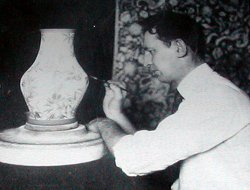
Hentschel at Rookwood
“Billy” Hentschel was a very important proponent of Modernism in the early 20th century Cincinnati Art Pottery movement as well as within a diverse range of other media including oil, airbrush, leather work, textile design and interior and exterior decorative arts.
Information on this important American artist isn’t widely known, as a Google search can quickly attest but, thanks to the research of Nick and Marilyn Nicholson and Virginia Raymond Cummins, we can glimpse this extraordinary talented man who helped define the modern taste for the post WWII American generations.
William Ernst Hentschel was born in New York City in 1892.
The date of Hentschel’s exact arrival in Cincinnati isn’t known but, as Nick and Marilyn Nicholson pointed out in an article written for the Kenton County Historical Society’s excellent quarterly magazine Heritage (Spring/Summer 1997), the first Cincinnati reference to Hentschel is a credit in the Rookwood Pottery shape records for designing a cat paperweight in 1911.
In 1911, Billy Hentschel would have been 19 years old.
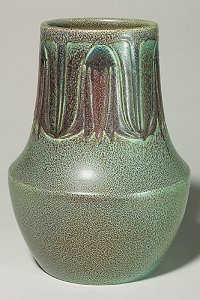
Within the 20th century’s Roaring Teens, young Hentschel, likely mentored by older and indulgent Rookwood artists, attended the Cincinnati Art Academy and pushed the envelope of pottery decoration, as can be seen in this Ombroso glazed vase from 1915 sold yesterday in the CAG Spring Sale, while becoming an important design voice within Rookwood’s new Architectural Faiance department.
Hentschel’s fiery nature, suggested by his daring artistic foresight, comes into yet sharper focus when one contemplates his tempestuous relationship and first marriage to Cincinnati dance instructor and performer Halina Feodorova.
While little is known of this relationship, Virginia Raymond Cummins, in her excellent Rookwood Potpourri writes that:
The marriage was not a happy one and ended in divorce.
I have to imagine, reading heavily between the lines of Cummins' one sentence, that the young Hentschel, the pet of many prominent Cincinnati artists and with an exotic Russian dancer on his arm, cut a wide swath in boomtown and labor troubled Cincinnati’s early 20th century social scene.
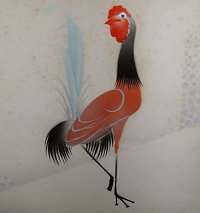
Rooster, aquatone, circa mid to late 1920's
Indeed this favorite image of Hentschel’s pioneering work with airbrush and frisket, salvaged from a Delaware estate, lovingly conserved and from the period of Hentschel’s relationship with Feodorova, seems, though an image of a Rooster, more imbued with a certain dancer’s defiant stance and Russian hauteur.
By the mid 1930’s, according to the Nicholson’s Kenton Hills Porcelains, “Hentschel’s [first] marriage had dissolved”.
The 29 year-old Hentschel became in instructor at the Cincinnati Art Academy in 1921 and, throughout the Roaring 20’s and 30’s, worked in leather, batik and his airbrushed Aquatones all while continuing his work at the Rookwood Pottery.
In 1939, a pivotal year, Hentschel again married (this time a former Art Academy student and fellow Rookwood decorator Alza Stratton) and joined ranks with a small group of Rookwood employees disgruntled with the pottery’s short-sighted and old school business practices by leaving the pottery and starting the short-lived Hentschel-Bopp or Harold Bopp Pottery which then became the equally short-lived Kenton Hills Porcelains in Villa Hills, Kentucky.
Bopp, a Rookwood chemist who had argued for modern kilns before the pottery’s deaf management, found his modest revenge in the superb glazes produced by his new company’s modern kiln.
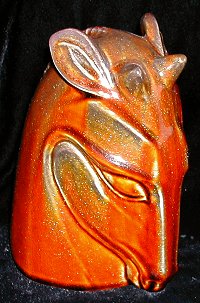
The Goldstone effect has tiny bits of what appear to be gold underglaze.
A particular triumph was the achievement of a glaze rivaling Rookwood unrepeatable Goldstone effect as seen in this Kenton Hills horse sculptural entitled Nemo and designed by Hentschel.
Hentschel, Bopp and David Seyler’s fledgling Kenton Hills pottery ended with the arrival of World War II.
According to the Nicholson’s:
By early 1943, all firing had ceased.
In 1944, Hentschel stopped teaching at the Art Academy and began to explore oil painting.
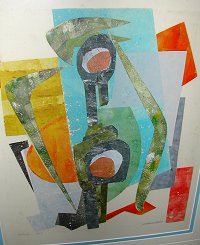
Kakapo I circa mid 1950's
By the early 1950’s he had modified his Aquatone airbrush technique by creating “brayer” stencil paintings such as this example of a limited signed and numbered series of 25 entitled Kakapo I.
The contrast between the Rooster aquatone produced amid the joie de vie of Hentschel’s youth and the somber post nuclear fowl shown in the 50 year old Hentschel’s Kakapo I is, I feel, a stark testament to what young Billy’s century of progress became.
William Ernst Hentschel died in 1962 and is buried in Lexington, Kentucky.
Note
I would highly recommend the Rookwood artist biographical sketches contained in Virginia Raymond Cummins Rookwood Pottery Potpourri as well as the Nicholson’s excellent Kenton Hills Porcelains.
The Cincinnati Art Galleries published Rookwood Pottery Potpourri while the Nicholson’s book was self-published.
I know the superb staff at the CAG would be happy to answer any question regarding reference materials.
Further examples of Hentschel's "breyer" work can be found at the Annex Galleries while other examples of his Kenton Hills work can be found in this June 10, 2004 post.
Images: Nick & Marilyn Nicholson, Mark Mussio, sean


